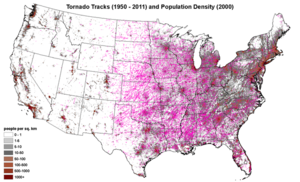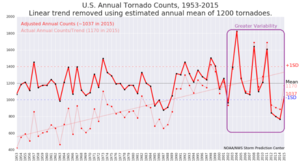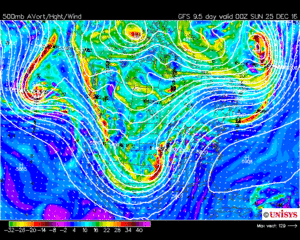Science Magazine says:
The number of tornadoes pounding the United States during the most extreme outbreaks has roughly doubled over the past 50 years, a new analysis shows. But the study also yields a big surprise: The increased severity of such tornado outbreaks, at least at first glance, doesn’t seem to be related to climate change.
‘Outbreak tornadoes are on the rise’ articles are on the rise. Why? Because of a Mathematician named
Michael Tippett at Columbia University who recently made some bold statements:
The number of tornadoes in outbreaks is increasing. And the number of tornadoes in the most extreme outbreaks — those where at least a dozen tornadoes hit a region within one to three days — is increasing the fastest.
Trippet further states:
It’s not the expected signature of climate change. It could be either something else, or we really don’t understand what climate change is doing. The increase doesn’t seem to be related to better reporting in recent years so the trends seem to be genuine. The team then looked to weather data for a scientific explanation.
His comments resulted in the following top-ranking articles on
Google:
NPR:
Tornado Outbreaks Are On The Rise, And Scientists Don’t Know Why
CSM:
Is climate change causing more extreme tornado outbreaks?
CBS:
Biggest tornado outbreaks are spawning more twisters
Climate Central:
Extreme Tornado Outbreaks Are Becoming More Extreme
In-Depth:
Tornado swarms are on the rise — but don’t blame climate change
While each author offers an opinion of his/her own, many seem far from valid. In fact, a tiny amount of common sense goes a long way when considering reasons why all of a sudden it’s news that more tornadoes occur during outbreaks then did 50 years ago. Trippet’s lack of expansion on reporting trends is where I take my opportunity to interject a theory — and it has absolutely nothing to do with the weather itself.
Timing is everything
Let’s start with the fact that comparison stats begin at 50 years ago. Take a look at the map and consider population increases and the space this population increase now occupies. If you need a visual aid to fully comprehend population growth and shifts, check out the new
Google Timelapse. It seems most plausible that more people in more places equals more eyes on the sky resulting in more reports.

Courtesy: NOAA Storm Prediction Center
Advances in technology
Reporting tornadoes has never been easier than it is today. It will become even easier with crowdsourced weather becoming mainstream. 50 years ago? Not so much. In fact, even 10 years ago, reporting a tornado was not anywhere near as easy as it is today. Let’s consider reporting avenues over the last three decades:
- 2000’s: 10 years ago we weren’t all carrying smart phones with the ability to open an app and instantly report, call a NWS WFO, contact local authorities, etc.
- 1990’s: The internet was in it’s infancy. Public reporting prior to, and during much of this period, was by called or radioed in only.
- 1980’s: Home telephones, amateur radio and citizens band radio were primary means for reporting. HAM radio and CB were the only mobile means by which one could report or relay a report of a tornado sighting.
 Awareness is key
Awareness is key
Between broadcast media, social media and efforts by the NWS and private weather industry, the general public is more weather-aware than ever. Those who are aware of the potential are more likely to ‘spot’ a tornado because they’re looking for one.
Storm Chasing
Over the last 30 years storm chasing has become popular. Over the past 10 years the number of storm chasers has grown exponentially. Hundreds of people driving to the vicinity of threatening radar signatures will no doubt net a higher number of tornado reports. Some of these needles-in-the-haystack might not otherwise have been reported.
What do YOU think?
Original article:
https://medium.com/@SteveMillerOK/o...-rise-heres-my-theory-772225a8eb9f#.kkvblnjj0



